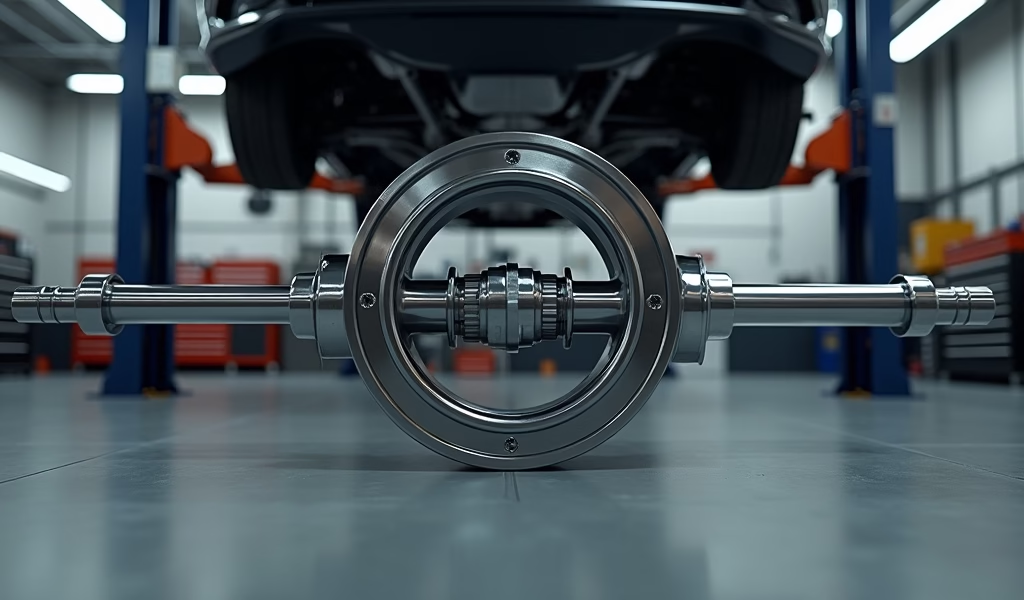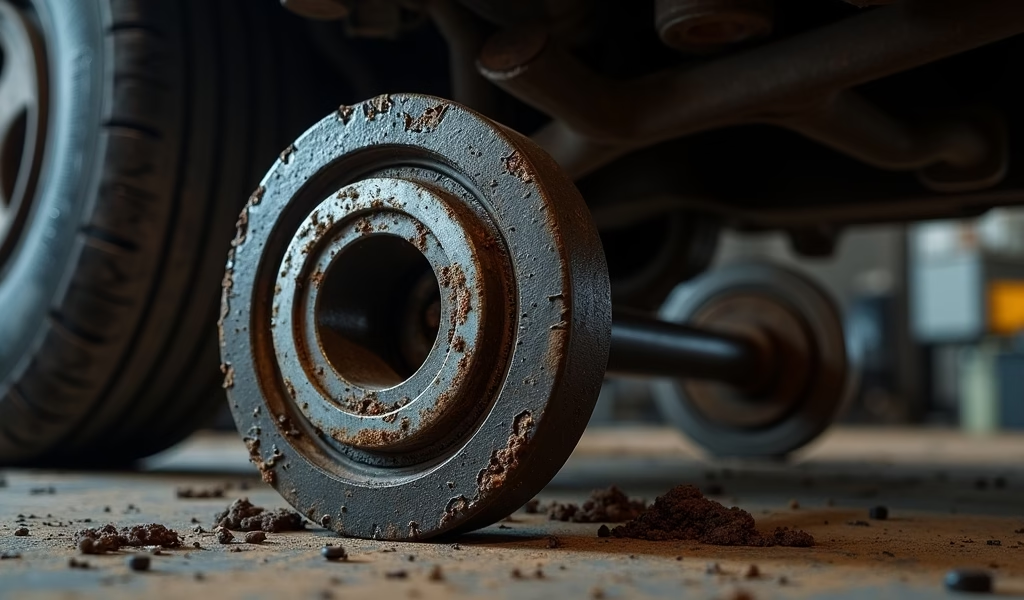Overview
Universal joint cross bearings (U-joints) are critical drivetrain components that enable power transmission between shafts at different angles, requiring regular maintenance through proper lubrication, inspection for warning signs like unusual noises or vibrations, and quality replacements when worn. This guide covers everything from identifying different U-joint types and warning signs of failure to proper maintenance procedures, DIY replacement techniques, and troubleshooting common issues to maximize component lifespan and prevent costly drivetrain damage.
Table of Contents
- What Is a Universal Joint Cross Bearing?
- Common Types of Universal Joint Cross Bearings
- Warning Signs of Failing U-Joints
- Inspection Techniques: Catching Problems Early
- Proper Lubrication: The Key to Longevity
- Replacement Guide: DIY Tips for Success
- Choosing Quality Replacements: Not All U-Joints Are Equal
- Preventative Maintenance: Extending U-Joint Life
- Troubleshooting Common Issues
- Conclusion
- Frequently Asked Questions
What Is a Universal Joint Cross Bearing?
That mysterious clunking sound coming from underneath your vehicle? It might be your universal joint cross bearing trying to tell you something. These small but mighty components—commonly called U-joints—are the unsung heroes of your drivetrain system.
A universal joint cross bearing resembles a cross or X-shape with bearings at each end. This clever design allows power to be transmitted between two shafts that are at different angles to each other. Think of it as the flexible connector that lets your driveshaft keep spinning even as your suspension moves up and down over bumpy roads.
In most vehicles, you’ll find these U-joints in the driveshaft assembly, connecting your transmission to the differential. They’re particularly crucial in rear-wheel-drive and four-wheel-drive vehicles, where they handle the constant angle changes between components as you drive over varying terrain.
Without properly functioning universal joint cross bearings, the power from your engine wouldn’t make it to your wheels as your suspension articulates. They’re small parts with a massive responsibility—transferring all that horsepower while accommodating the twists and turns of real-world driving.
Common Types of Universal Joint Cross Bearings
Just like there’s more than one way to fix a car, there’s more than one type of universal joint cross bearing. Each has its own advantages depending on your vehicle and driving habits.
- Standard Cross and Roller Bearings: The most common type, featuring a cross-shaped center with four trunnions (the arms that stick out) and needle bearings.
- Greasable U-Joints: These include zerk fittings that allow you to add fresh grease periodically, extending their lifespan significantly if maintained properly.
- Sealed (Non-Greasable) U-Joints: These come pre-lubricated and sealed at the factory. When they wear out, replacement is the only option since you can’t service them.
- Double Cardan Joints: More complex systems using two U-joints to create a constant velocity joint, often found in front driveshafts of four-wheel-drive vehicles.
- Heavy-Duty U-Joints: Beefed-up versions designed for trucks, off-road vehicles, and commercial applications where regular U-joints would fail under stress.

Warning Signs of Failing U-Joints
Your vehicle has a way of speaking to you when things aren’t right. When it comes to universal joint issues, the language is pretty clear if you know what to listen for.
Strange Noises
- A rhythmic clicking or clunking, especially noticeable during acceleration or when shifting from drive to reverse
- Squeaking sounds at low speeds (often a cry for lubrication)
- Metallic grinding—this is serious and suggests imminent failure
Vibrations
- Vibrations that get worse as you increase speed
- A shuddering sensation you can feel through the floorboard
- Driveline vibrations that change when accelerating versus coasting
Visual Clues
- Rust-colored powder around the joint area (indicates seal failure)
- Visible movement or “play” in the driveshaft when rocked by hand
- Missing or damaged dust caps or seals
Handling Changes
- Resistance when shifting gears
- Delayed or jerky power delivery
- Difficulty maintaining consistent speed
Ignoring these symptoms is like ignoring a toothache—the problem won’t fix itself, and the longer you wait, the more painful (and expensive) it becomes. A failing U-joint can eventually break completely, potentially leaving you stranded or causing additional damage to your vehicle’s drivetrain.
Inspection Techniques: Catching Problems Early
You don’t need to be a master mechanic to check your universal joint cross bearings. Regular inspection can save you from costly repairs down the road. Here’s how to become a U-joint detective:
The Hands-On Approach
Safety first! Always ensure your vehicle is properly supported on jack stands before getting underneath it.
- The Rock Test: Grab the driveshaft and try to move it back and forth (not around). Any noticeable movement or “play” suggests worn U-joints.
- The Rotation Check: Slowly rotate the driveshaft by hand, feeling for any binding, catching, or unevenness in the rotation.
Visual Inspection Checklist
- Look for rust-colored powder around the bearing caps—this is a telltale sign of seal failure
- Check for missing or damaged seals
- Inspect for physical damage to the cross
- Look for excessive grease fling-off, which indicates seal failure
For daily drivers, performing this inspection every 30,000 miles works well. However, if you frequently tow heavy loads or tackle off-road adventures, checking your universal joints every 15,000 miles is a smarter move.
Remember, preventative maintenance is always cheaper than emergency repairs. Taking ten minutes to inspect your U-joints could save you hours of being stranded and hundreds of dollars in additional damage.
Proper Lubrication: The Key to Longevity
When it comes to universal joint cross bearings, proper lubrication isn’t just helpful—it’s essential for survival. Think of it as giving your U-joints a refreshing drink when they’re thirsty.
Choosing the Right Grease
For most automotive applications, a high-quality NLGI #2 lithium-based grease works perfectly. However, special applications may require different formulations:
- Heavy-duty applications: Moly-fortified greases provide extra protection under extreme pressure
- High-temperature environments: Synthetic grease with a high dropping point
- Marine applications: Water-resistant marine grease to prevent washout
Lubrication Frequency
For greasable U-joints, follow this schedule:
- Normal driving: Every 5,000-10,000 miles
- Severe conditions (off-road, towing, dusty environments): Every 3,000-5,000 miles
According to Spicer Driveline experts, proper lubrication can double or triple the life of your U-joints compared to neglected ones.
The Right Way to Grease
Here’s a common mistake: over-greasing. Contrary to popular belief, more isn’t always better. Excessive grease can rupture seals, collect dirt, and actually accelerate wear.
Apply grease until you see a small amount purge from the seals, then stop. This indicates the bearing is full without being over-packed. If you’re greasing and don’t see any purging, one of your seals might be clogged or the bearing could be damaged.
For sealed U-joints, there’s no maintenance option—they’re designed to be replaced when worn. That’s why many professional mechanics prefer greasable designs for vehicles that will be kept long-term.

Replacement Guide: DIY Tips for Success
Replacing a universal joint cross bearing might seem daunting, but with the right approach, it’s quite manageable for the mechanically inclined. Let’s break it down into bite-sized steps.
Essential Tools
- U-joint press or bench vise with socket adaptors
- Hammer
- Socket set
- Needle-nose pliers
- Snap ring pliers
- Penetrating oil
- Clean rags
Step-by-Step Replacement
- Remove the Driveshaft: Mark the position relative to the differential and transmission flanges to maintain proper balance.
- Secure in Vise: Support the yoke properly to prevent damage.
- Remove Snap Rings: Use appropriate pliers to remove the retaining clips.
- Press Out the Old Joint: Using a U-joint press or properly sized sockets and a vise.
- Clean and Inspect: Thoroughly clean the yoke ears and check for damage.
- Install New Joint: Press in the new cross bearing carefully, ensuring the grease fittings (if present) are properly positioned.
- Replace Snap Rings: Ensure they’re fully seated in their grooves.
- Grease the New Joint: Apply lubricant through the zerk fitting until you see slight purging at all four bearings.
- Reinstall the Driveshaft: Align your earlier marks to maintain balance.
Research from Motor Magazine shows that improper installation causes over 60% of premature U-joint failures. Take your time and do it right the first time.
Common Installation Mistakes to Avoid
- Forcing components: Never hammer directly on bearings
- Improper alignment: Misaligned installation causes premature failure
- Forgetting to grease: Initial lubrication is critical before first use
- Reusing snap rings: Always use new retention hardware
If you’re not comfortable with this procedure, there’s no shame in seeking professional help. A properly installed U-joint will provide thousands of miles of trouble-free service.
Choosing Quality Replacements: Not All U-Joints Are Equal
The market is flooded with universal joint cross bearing options, from budget-friendly parts to premium alternatives. That $12 U-joint might seem like a bargain, but is it really worth it in the long run?
Quality Indicators
- Construction Material: Look for hardened steel crosses and heat-treated components
- Bearing Design: Needle bearings should be evenly spaced and high in number
- Seal Quality: Triple-lip seals offer superior contamination resistance
- Weight: Quality U-joints typically have more substantial weight due to better materials
- Greasable Design: For most applications, greasable designs offer longer service life
Trusted Brands Worth Considering
- Spicer/Dana
- Moog
- Precision
- GMB
- Timken
While premium brands might cost 20-30% more upfront, they frequently deliver double or triple the service life—making them the more economical choice over time. It’s the classic “buy nice or buy twice” scenario.
When I replaced the U-joints on my old F-150, I went with budget parts the first time. Six months later, I was back under the truck doing the same job again. The second time, I sprung for quality Spicer parts, and three years later, they’re still going strong. Lesson learned!
Preventative Maintenance: Extending U-Joint Life
Like a well-orchestrated symphony, proper universal joint maintenance follows a rhythm and pattern. Let’s establish a maintenance schedule that will keep your U-joints happy and your wallet even happier.
Maintenance Schedule by Driving Condition
| Driving Condition | Inspection Interval | Lubrication Interval | Expected Lifespan |
|---|---|---|---|
| Normal/Highway | 30,000 miles | 10,000 miles | 80,000-100,000 miles |
| Towing/Heavy Load | 15,000 miles | 5,000 miles | 50,000-80,000 miles |
| Off-Road | 10,000 miles | 3,000 miles | 30,000-50,000 miles |
Extending U-Joint Life: Pro Tips
- Avoid Extreme Angles: Excessive driveshaft angles accelerate wear. If you’ve lifted your truck, consider a driveshaft angle correction kit.
- Smooth Driving: Jerky acceleration and hard shifts stress U-joints. A gentle touch on the gas pedal pays dividends.
- Regular Cleaning: After off-road adventures, rinse mud and debris from your undercarriage to prevent abrasive wear.
- Address Alignment Issues: If your vehicle has been modified with a lift kit or suspension changes, have the driveline angles checked by a specialist.
Remember, preventative maintenance isn’t just about the components themselves—it’s about the entire driving experience. How you drive affects how long these parts last.
Troubleshooting Common Issues
Even with the best maintenance, problems can arise. Let’s tackle some common U-joint issues and their solutions.
Problem: Clicking During Acceleration
Potential Causes:
- Worn needle bearings
- Damaged cross
- Loose yoke bolts
Quick Fix:
Tighten any loose fasteners and check for excessive movement in the driveshaft. If play is present, plan for U-joint replacement soon. You might get away with a couple hundred more miles, but don’t push your luck too far.
Problem: Constant Vibration
Potential Causes:
- Unbalanced driveshaft
- Worn center support bearing
- Phasing issues between U-joints
Quick Fix:
Inspect the entire driveline for obvious damage. In emergency situations, reducing speed can minimize vibration until proper repairs can be made. Vibrations tend to appear at specific speeds, so finding a “sweet spot” below that speed might get you home.
Problem: Seized U-Joint
Potential Causes:
- Lack of lubrication
- Contamination
- Extreme duty cycles
Quick Fix:
There’s no quick fix for a seized U-joint—immediate replacement is necessary to avoid catastrophic driveline failure. If you’re stranded, calling a tow truck is your best option. Trying to “break it free” will only cause more damage.
When to Call the Professionals
While many U-joint issues can be addressed by a competent DIYer, certain scenarios warrant professional intervention:
- Driveshaft balancing requirements
- Specialized tooling needs
- Vehicles with complex electronic driveline controls
- When multiple components show damage
There’s no shame in knowing when a job exceeds your tools or expertise. Sometimes, paying a pro saves money in the long run.
Conclusion
Universal joint cross bearings might be small components in the grand scheme of your vehicle, but their importance can’t be overstated. These mechanical marvels enable the flexibility your drivetrain needs while transferring enormous torque loads under challenging conditions.
By following the tips we’ve covered—regular inspection, proper lubrication, correct installation, quality selection, and preventative maintenance—you can ensure these crucial components provide reliable service for years to come. Remember, the humble U-joint doesn’t ask for much: just a little attention, occasional grease, and respectful driving habits.
Ignoring these maintenance basics is like ignoring your dental health—eventually, something will break, and the fix won’t be pleasant or cheap. A stitch in time saves nine, especially when it comes to driveline components.
Whether you’re a weekend warrior tackling your own repairs or someone who prefers to leave it to the professionals, understanding what makes your vehicle tick helps you make informed decisions about maintenance and repairs. Your vehicle takes care of you on every journey—return the favor by taking care of its critical components.
Frequently Asked Questions
How long should universal joint cross bearings last?
Under normal driving conditions, quality U-joints typically last 50,000-100,000 miles. However, lifespan varies significantly based on driving conditions, maintenance practices, and component quality.
Can I drive with a bad universal joint?
While technically possible for short distances, it’s extremely risky. A failing U-joint can completely separate, causing driveshaft disconnection and potential loss of vehicle control.
Are non-greasable U-joints better than greasable ones?
Non-greasable joints offer convenience but cannot be maintained. Greasable U-joints typically provide longer service life when properly maintained, making them preferable for severe duty applications.
How much does it cost to replace universal joint cross bearings?
DIY replacement costs range from $20-100 for parts alone, depending on quality and vehicle. Professional replacement typically runs $150-400 including labor.
Can U-joint failure damage my transmission?
Yes, severe U-joint failure can cause vibrations that damage transmission components including output shafts and bearings. Early intervention prevents costly cascading damage.

